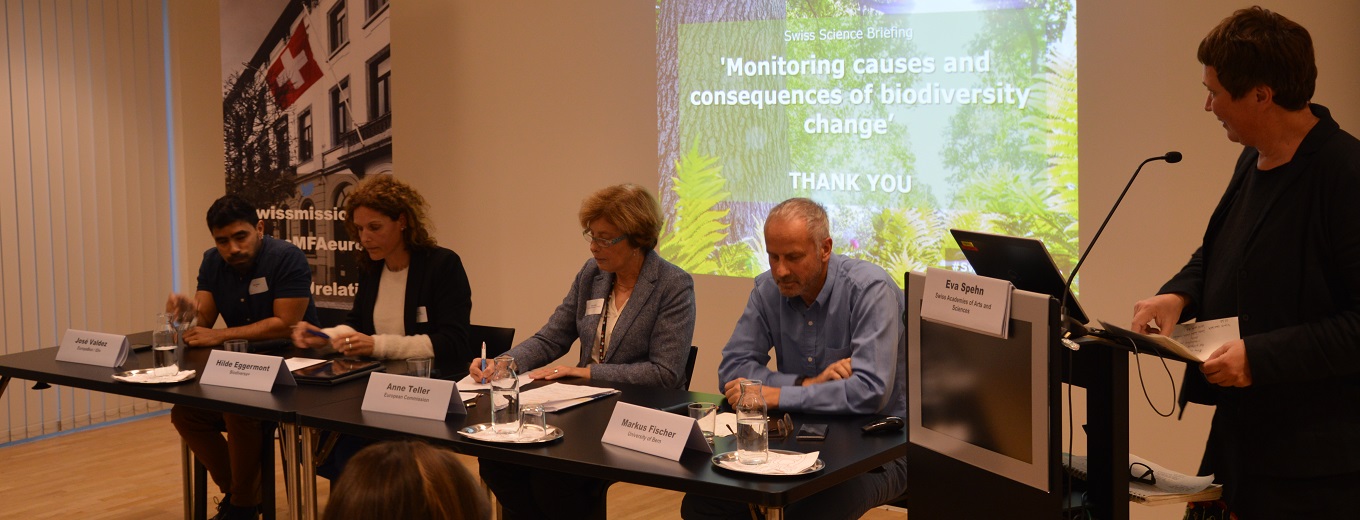Experts discussed the role of biodiversity monitoring, existing research and gaps, and how Swiss-EU collaboration supports addressing biodiversity loss.
Global biodiversity loss and degradation of ecosystems continue at an alarming speed despite ongoing counter-efforts on national, European and international levels, and urgent action is needed. In this context, the Mission of Switzerland to the EU, the Swiss Academies of Arts and Sciences, and SwissCore jointly organised the Swiss Science Briefing on ‘Monitoring causes and consequences of biodiversity change’ on 19 October 2022.
The Swiss Ambassador to the EU, Rita Adam, indicated in her opening speech that challenges, such as biodiversity loss and the degradation of ecosystems, can only be addressed together in cooperation across borders. She highlighted that Switzerland is intensively engaged at national, European, and international levels to combat biodiversity loss. She also underlined that cooperation between the EU and Switzerland in research and innovation has a long institutional tradition. She also reaffirmed Switzerland’s willingness to begin negotiations on association to the Horizon package, and indicated that a full association, which will enable networks and cooperation built over years to persist, remains the Federal Council’s declared goal.
The opening speech set the scene for University of Bern Professor Markus Fischer’s keynote speech ‘Causes and consequences of biodiversity change: monitoring and knowledge gaps’. He emphasised that according to the Intergovernmental Platform on Biodiversity and Ecosystem Service (IPBES)’s Global Assessment 2019, more species are threatened than ever since humans evolved. He explained that Earth had experienced five periods when at least half of the living creatures were wiped out during the last 500 million years and that there is a probability that this could also become true for the homo sapiens. According to him, effective pathways for long-term societal transformation to reverse biodiversity loss are needed, namely through increased conservation efforts with sustainable production and consumption patterns. He described that the EU Biodiversity Strategy, with EUR 20 billion funding per year for biodiversity, puts the EU in a leading position in the world in addressing the global biodiversity crisis, and that in the EU, there is currently more knowledge available than in other parts of the world. He described that the EU is leading in coming up with a new Post-2020 Global Biodiversity Framework that aims to achieve a Living in Harmony with Nature. Then he provided an overview on the Swiss biodiversity-related monitoring programmes and explained that Swiss research provides excellent individual research on all aspects of the IPBES Conceptual Framework, experimental research, research on Biodiversity-Climate Change interaction as well as collaboration of research and monitoring communities. He concluded that biodiversity research is still largely scattered, and that biodiversity-related monitoring is focused too narrowly on biodiversity change but should focus on the whole social-ecological system instead. Finally, he added that research and monitoring are complementary: Research is needed to address knowledge gaps, and especially focus on mechanisms, indicators, successes, failures, and scenarios, while biodiversity-related monitoring of indicators is required for the whole social-ecological system. Therefore, both research and monitoring, would largely benefit from integrated social-ecological study designs, and indicated that currently “research and monitoring are synergistic but could be much more so”.
The panel, moderated by Eva Spehn, Science Officer at the Swiss Biodiversity Forum at the Swiss Academies of Arts and Sciences and IPBES delegate for Switzerland, focused on monitoring activities in Switzerland, the EU and beyond, current gaps, how collaboration can contribute to it and where Swiss-EU collaboration can even be improved:
Anne Teller, Senior Expert, Biodiversity Unit, DG Environment, European Commission (EC), explained that the EC’s ambition is to advance in biodiversity research and monitoring, and to raise awareness on the alarming situation of biodiversity loss and degradation of ecosystems. She explained how the EC plans that initiatives be built closer together, indicating that EuropaBON is mandated to table a proposal for a European Biodiversity Observation Network in 2023. The biodiversity partnership – Biodiversa+ – is closely associated, inter alia to test the proposal on the ground and provide feedback. The Science Service for Biodiversity should fill the gaps in a stepwise manner, based on policy priorities. The EU Knowledge Centre for Biodiversity (KCBD) aims to interconnect all actors with the policy sector as a science-policy interface to ensure that Member states will engage in this ambitious network as the crucial question remains funding. Consequently, private and public, EU, national, regional funding for monitoring should be increased considerably. She further said, “we will launch a Global Knowledge Centre for Biodiversity at COP15 in Montreal later this year – and we invite Switzerland to join.” The idea is to federate with UNEP-WCMC, CBD Secretariat and hopefully other initiatives like GEO BON / the Global Biodiversity Observation System (GBIOS), and the Global Biodiversity Information Facility (GBIF) to be servicing Parties, and be inclusive, covering all aspects of the post-2020 Global Biodiversity Framework, namely, conservation, sustainable use, access and benefits of genetic resources and means of implementation.
Hilde Eggermont, Chair and Coordinator of Biodiversa+ and Belgian Focal Point for the Intergovernmental Platform for IPBES, indicated that one particular strength of Biodiversa+ is its geographical coverage and composition, with members representing both research policy actors and environmental policy actors, allowing to efficiently bridge between science and policy. The partnership is currently composed of 74 partners from the EU, Switzerland and beyond to pull resources, increase efficiency of transnational collaboration and reduce fragmentation. She indicated that Biodiversa+ is building on the Biodiversa experience, now covering a broader portfolio of activities (e.g. including biodiversity monitoring activities) and with a larger budget. She explained that EuropaBON and Biodiversa+ are closely working together towards the common goal of setting up a pan-European network of harmonized biodiversity monitoring schemes. She said that EuropaBON and Biodiversa+ are very complementary, with outcomes from EuropaBON being tested at the country level through Biodiversa+, being composed of those actors that fund and steer the monitoring schemes. She also highlighted the strong collaboration with the EU Knowledge Centre for Biodiversity (KCBD) and European Environment Agency (EEA) across the different monitoring activities (including harmonisation of methods, protocols, and data interoperability; development of new tools and methods for biodiversity monitoring; and use of monitoring data by R&I and decision makers). Furthermore, she insisted that there is a need to better connect research and monitoring, and to involve a broader range of ministries to mainstream across different sectors. Finally, she also mentioned that Swiss researchers are very engaged in Biodiversa / Biodiversa+ through the Swiss National Science Foundation (SNSF) and have thus so far participated in 8 calls for research proposals with an average success rate of 30%. Ms. Eggermont invited the Swiss Federal Office for Environment (FOEN) to participate in Biodiversa+ to build in the experience from the Swiss biodiversity-related monitoring programmes in the European-wide observation network and increase their capacity.
José Valdez, Task Leader WP 4, EuropaBon, German Centre for Integrative Biodiversity Research (iDiv), Halle-Jena-Leipzig, explained that EuropaBon aims to identify data needs of policies and targets aligned with the European Green Deal. EuropaBon’s objective is to develop a European wide biodiversity network, considering many different aspects, such as monitoring, bottlenecks of monitoring, identification of modern technologies (e.g. AI, remote sensing), but also work with Biodiversa+ and identifying the indicators that should be included for monitoring. Cooperation is essential for the EuropaBon projects, focusing on stakeholder engagement, to be able to identify the needs across EU. He also invited more Swiss stakeholders to join the EuropaBon network in which 58 countries are currently participating.
Professor Markus Fischer finalised the panel with the perspective that research is not effective if it doesn’t reach to protect butterflies, and indicated that especially now in the current crisis, we have to continue the efforts to address biodiversity loss. Monitoring should inform on an integrated approach, where all continents but also people are integrated to change mindsets and provide wellbeing.

